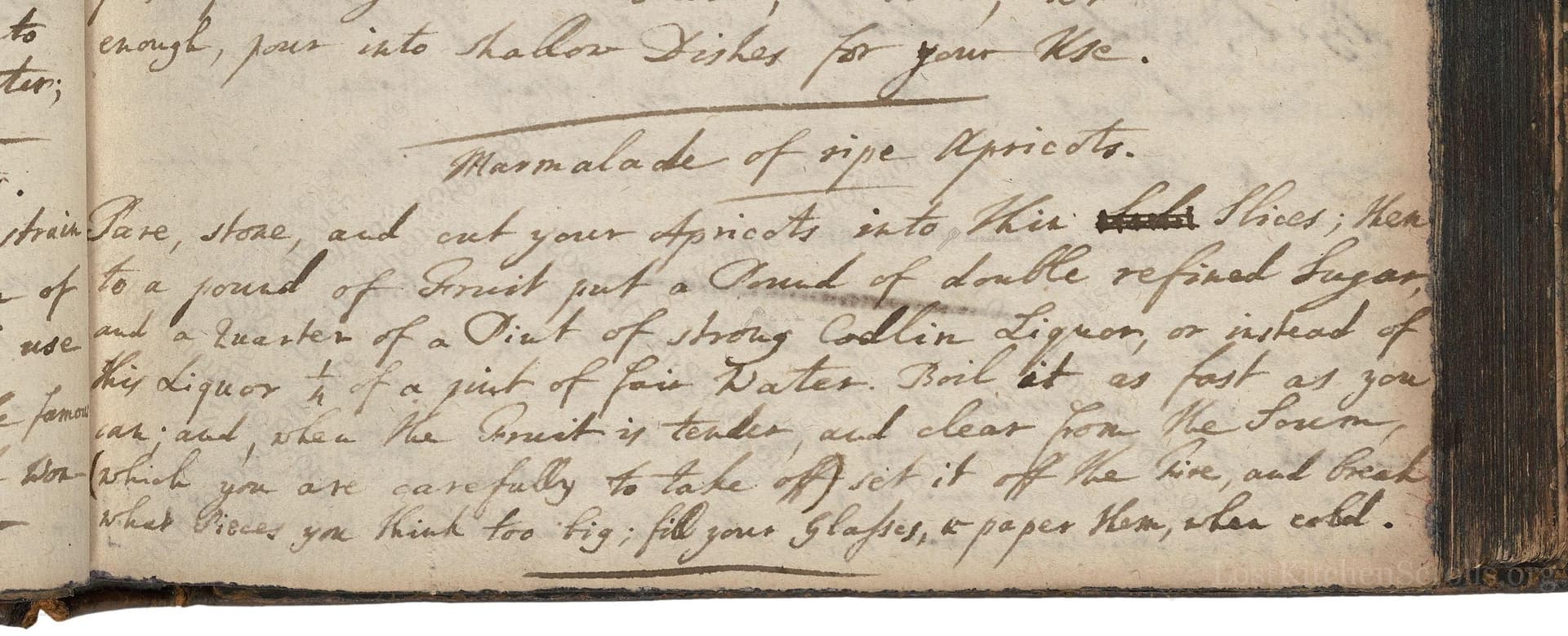Marmalade Of Ripe Apricots
From the treasured pages of Medicinal recipes compiled by Andrew Slee
Written by Andrew Slee

Marmalade Of Ripe Apricots
"Pare, stone, and cut your Apricots into thin Slices; then to a pound of Fruit put a Pound of double refined Sugar, and a Quarter of a Pint of strong Cordial Liqueur, or instead of this Liquour ¼ of a pint of fair Water. Boil it as fast as you can; and, when the Fruit is tender, and clear from the Scum, which you are carefully to take off; Set it off the fire, and break what Pieces you think too big; fill your Glasses, & paper them, when cold."
Note on the Original Text
This recipe was written in brief, imperative statements, as was typical in the 17th century, leaving out many details considered common knowledge at the time. Instructions such as 'paper them, when cold' assume the reader knows to cover preserves with parchment. Spelling follows period conventions—'liquour' for 'liqueur,' 'pare' for 'peel'—and uses ampersands and abbreviations in place of some modern conjunctions and words. The text is concise, focusing on sequence rather than explanation, reflecting the oral tradition of teaching cooks and household assistants.

Title
Medicinal recipes compiled by Andrew Slee (1654)
You can also click the book image above to peruse the original tome
Writer
Andrew Slee
Era
1654
Publisher
Unknown
Background
A delectable glimpse into 17th-century kitchens, this manuscript compiled by Andrew Slee promises an array of historical recipes and culinary secrets sure to delight any gourmand with a taste for the past.
Kindly made available by
Folger Shakespeare Library
This marmalade recipe hails from mid-17th-century England, attributed to the compiler Andrew Slee around 1654. At this time, English households were experimenting with tropical fruits and sugar, both newly affordable to European kitchens thanks to global trade. Recipes were recorded for domestic use and often assumed a great deal of background knowledge. This marmalade would have been a luxury preserve, showing off both rare fruits and the refinement of white sugar. Recipes like these denote both social status and an evolving palate, blending the continental tradition of fruit preserves with English ingenuity.

In the 1650s, cooks would have used a large brass, copper, or iron preserving pan for boiling fruit and sugar. A skimmer (long-handled, flat spoon) was essential for removing scum. For stirring, a sturdy wooden spoon was standard. Peeling and slicing apricots required a small, sharp paring knife, and a stone mortar and pestle might have been used to break up any larger fruit pieces if needed. The finished marmalade was then poured into wide-mouthed glass jars or pots and covered with parchment or writing paper cut to size and fixed on with string or paste when cold.
Prep Time
15 mins
Cook Time
20 mins
Servings
8
We've done our best to adapt this historical recipe for modern kitchens, but some details may still need refinement. We warmly welcome feedback from fellow cooks and culinary historians — your insights support the entire community!
Ingredients
- 1 lb ripe apricots (about 6-8 large apricots), peeled, pitted, and thinly sliced
- 1 lb double refined white sugar (granulated or caster sugar as a modern substitute)
- 4 fl oz (1/2 cup) strong cordial liqueur (such as Kirsch, orange liqueur, or schnapps) – or 4 fl oz (1/2 cup) water
Instructions
- Begin by peeling ripe apricots, removing their stones (pits), and slicing them thinly.
- For every 1 pound of prepared fruit, weigh out an equal amount (1 pound) of fine white sugar.
- Pour in 4 fluid ounces (1/2 cup) of either a strong fruit-based liqueur (such as kirsch, orange liqueur, or a clear schnapps), or, for a non-alcoholic version, substitute with 4 fluid ounces (1/2 cup) of water.
- Place everything in a large saucepan over high heat and bring swiftly to the boil, stirring frequently.
- Skim off any foam or scum that rises to the surface.
- Continue to boil rapidly until the apricot slices become soft and translucent, and the mixture thickens to a loose jam-like consistency.
- Crush or mash any large pieces to your preferred texture.
- While still hot, transfer the marmalade into clean jars.
- Allow to cool completely, then cover with parchment or waxed paper before sealing with lids.
Estimated Calories
160 per serving
Cooking Estimates
It takes about 15 minutes to prepare the apricots and sugar, and another 20 minutes to cook the marmalade until it sets. Each serving contains about 160 calories, and this recipe makes around 8 servings.
As noted above, we have made our best effort to translate and adapt this historical recipe for modern kitchens, taking into account ingredients nowadays, cooking techniques, measurements, and so on. However, historical recipes often contain assumptions that require interpretation.
We'd love for anyone to help improve these adaptations. Community contributions are highly welcome. If you have suggestions, corrections, or cooking tips based on your experience with this recipe, please share them below.
Join the Discussion
Rate This Recipe
Dietary Preference
Main Ingredients
Culinary Technique

Den Bockfisch In Einer Fleisch Suppen Zu Kochen
This recipe hails from a German manuscript cookbook compiled in 1696, a time whe...

Die Grieß Nudlen Zumachen
This recipe comes from a rather mysterious manuscript cookbook, penned anonymous...

Ein Boudain
This recipe comes from an anonymous German-language manuscript cookbook from 169...

Ein Gesaltzen Citroni
This recipe, dating from 1696, comes from an extensive anonymous German cookbook...
Browse our complete collection of time-honored recipes



